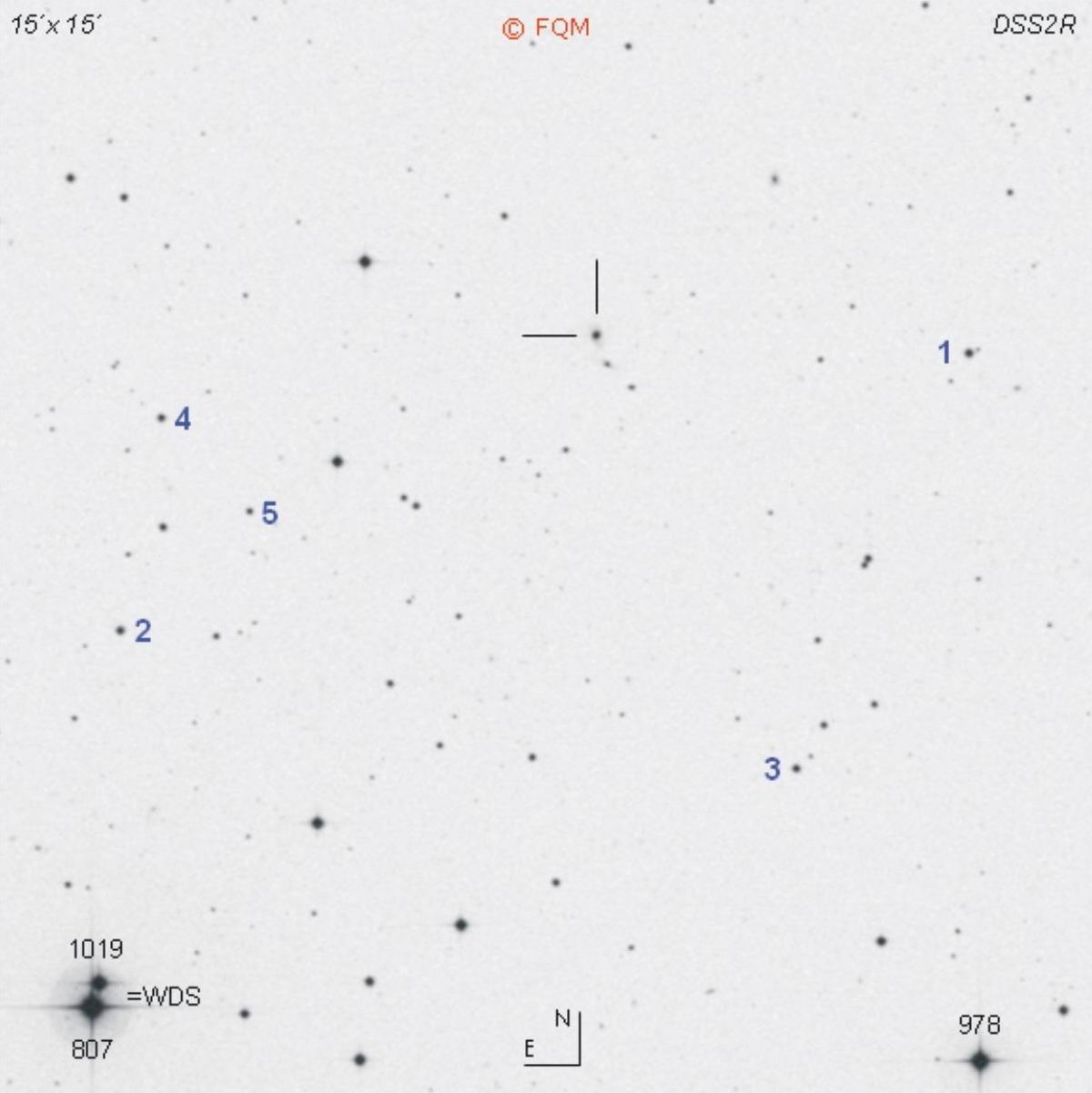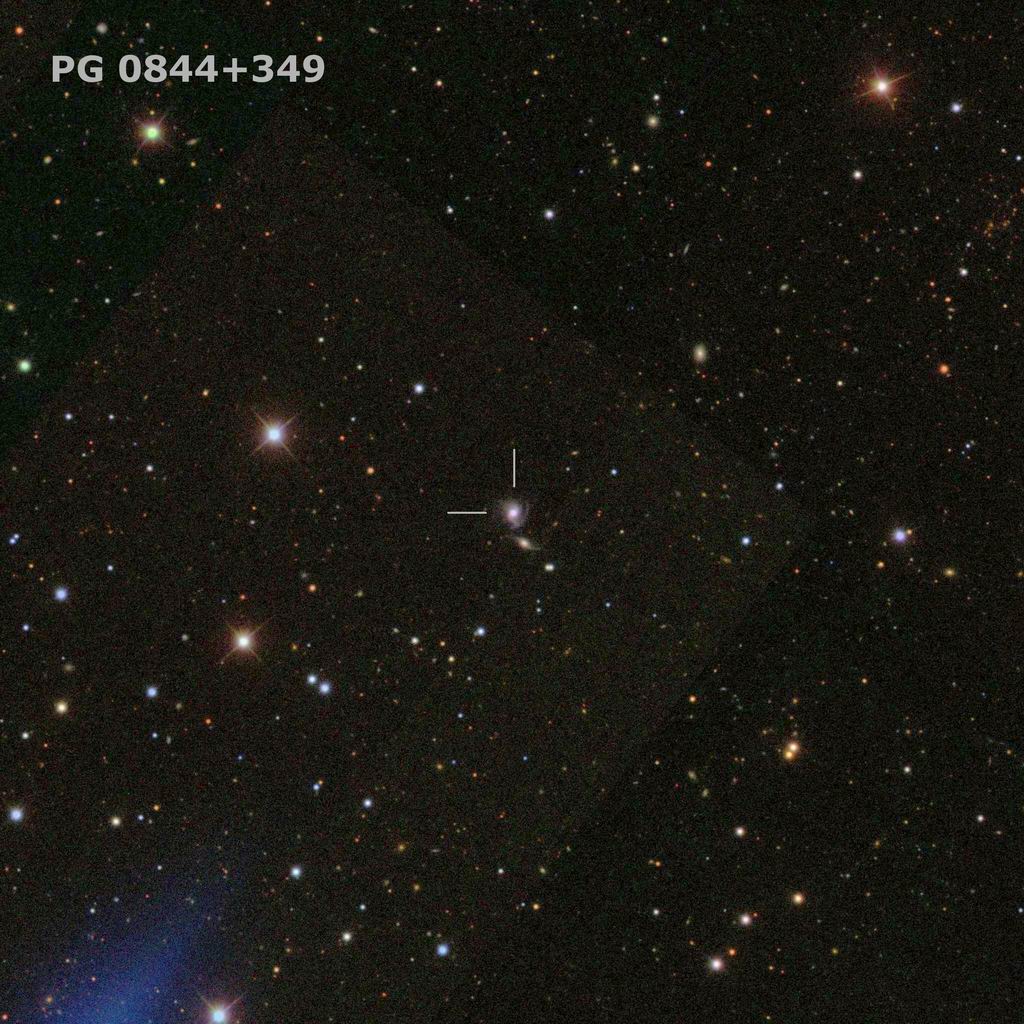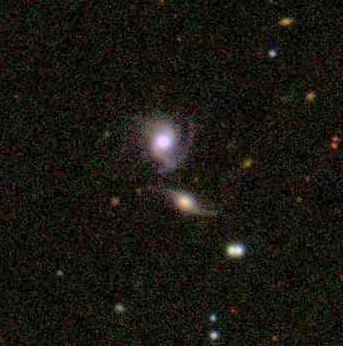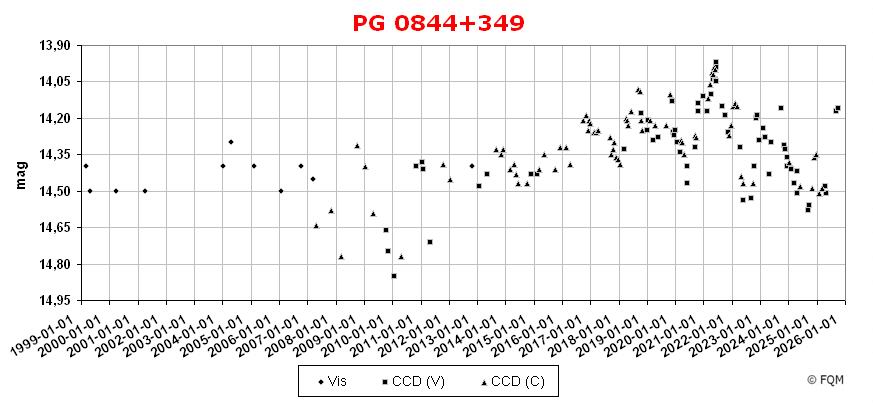
| Frankfurt Quasar Monitoring |
| PG 0844+349 |
| Cross-Identifications | TON 951, CSO 204, FBS 0844+349, PGC 24702 LEDA 24702, 1ES 0844+349, 2E 0844.5+3456 2MASSi J0847424+344504, RX J0847.6+3445 SDSS J084742.46+344504.4, 0844+349 |
| Equat. coordinates | RA 08 47 42.5 DE +34 45 05 (J2000) |
| Constellation | Lynx |
| Type | QSO |
| Redshift | z=0.064 |
| Distance (2) (3) |
262 Mpc |
| Total mag range (mv) (4) | 13.67 - 15.28 |
| Catalog Magnitude (1) | 14.50 |
| Absolute Magnitude (1) | -23.1 MB |
| Light Travel-Time (2) | 0.829 × 109 yrs |

Comparison stars
| star | B | V |
| 1 | 14.533 (0.033) |
13.999 (0.024) |
| 2 | 14.915 (0.033) |
14.253 (0.039) |
| 3 | 15.028 (0.047) | 14.455 (0.039) |
| 4 |
15.225 (0.080) | 14.703 (0.053) |
| 5 |
15.844 (0.038) | 15.394 (0.072) |



| PG
0844+349 is a radio-quiet quasar in southern Lynx, close to the constellation Cancer. The designation PG 0844+349
refers to the Palomar-Green Bright Quasar
Survey (PG), where this object was identified as a blue stellar object.
Independently, it was discovered by
mexican Tonantzintla Blue
Stellar Object Survey (TON), searching for blue stellar objects as
quasar candidates. Spectroscopic investigations revealed a Seyfert-1
spectrum, which led to the quasar classification. PG
0844+349 is a low luminosity quasar at a distance of about 800 million
light-years. The central supermassive black hole has an estimatet mass of 0.9x108 solar masses. A close inspection of images taken by POSS and SDSS (see above) easily reveals the host galaxy of quasar PG 0844+349 as a face-on spiral galaxy with an apparent diameter of 0.45×0.32 arcminutes. Close to the SE, a companion galaxy (2MASX J08474179+3444405) can be found at an apparent distance of some 20". Obviously, both galaxies show clear signs of tidal interaction, like tidal arms and a hot blue stellar component. This galaxy/quasar situation is a good example for AGN activity triggered by tidal interaction. PG 0844+349 is a small amplitude variable object with a total range of about 1.5 magnitudes. Observations by the Frankfurt Quasar Monitoring programme have shown the quasar as a bright object, ranging between 14.1 - 14.8 mag, which makes it an interesting object for visual observers with telescopes of 10- to 12-inch of aperture and larger. CCD observers, as well as visual observers, shall use the comparison stars given above. ____________
Observers who like to track down some more very old quasi-stellar photons may turn to
quasar B3 0754+394, a
bright 14-mag object at a distance of about 1.2×109
light-years,
11° WNW of PG 0844+349. Another 14-mag quasar is PG 0953+415 at a distance of about 2.5×109 light-years, some 15° NE in Leo Minor. And finally, sweep the telescope 14.7° to the south: Here we find OJ 287, a violently variable BL Lac object, close to open cluster M44, the “beehive”. Only 11´ SE of quasar PG 0844+349 observers find the bright double star WDS 08483+3436=ADS 7000 (A=8m.07, B=10m.19, AB=19.1“, 340°), see finding chart above (WDS at lower left corner). A deep sky showpiece can be found about 1.7° SE: NGC 2683, a large and bright edge-on galaxy. Another 13-mag galaxy, NGC 2649, is a small face-on spiral only 0.75° W of quasar PG 0844+349. |
| Boroson, T.A., Green, R.F. 1992, ApJS, 80, 109; The Emission-Line Properties of Low-Redshift Quasi-Stellar Objects. Bowen, D.V., Osmer, S.J., Blades, J.C., et al. 1994, AJ, 107, 461; Hubble Space Telescope Faint Object Spectrograph QSO Absorption Snapshot Survey (ABSNA). Chavira, E. 1959, BOTT, 2, 3; Estrellas azules en el Casquete Galactico Norte - II. Elvis, M., Wilkes, B.J., McDowell, J.C. 1994, ApJS, 95, 1; Atlas of Quasar Energy Distributions. Giveon, U., Maoz, D., et al. 1999, MNRAS, 306, 637G; Long-term Optical Variability Properties of the Palomar-Green Quasars. Hansen, T. 1991, Deep Sky Magazine 34, 32; The “Deepest” Deep Sky Objects. Karge, S.; Helle Quasare für 8- bis 10-Zoll Teleskope. Ein Beobachtungsführer zur visuellen Beobachtung von Quasaren und BL Lacertae Objekten; Frankfurt 2005. Peterson, B. M., Ferrarese, L., Gilbert, K. M., et al. 2004, ApJ, 613, 682; Central Masses and Broad-Line Region Sizes of Active Galactic Nuclei. II. Richards, G.T., Yanny, B., et al. 1997, PASP, 109, 39R; Quasar Photometry with the SDSS Monitor Telescope. Schmidt, M., Green, R.F. 1983, ApJ, 269, 352; Quasar Evolution derived from the Palomar Bright Quasar Survey and other Complete Quasar Surveys. Steinicke, W.; Katalog heller Quasare und BL Lacertae Objekte; Umkirch 1998. Steinicke, W.; Beobachtungsliste für helle Quasare; Umkirch 1999. Véron-Cetty, M.-P., Véron, P. 2001, A&A 374, 92; A Catalogue of Quasars and Active Nuclei: 10th edition. Véron-Cetty, M.-P., Véron, P. 2003, A&A 412, 399; A Catalogue of Quasars and Active Nuclei: 11th edition. Véron-Cetty, M.-P., Véron, P. 2006, A&A 455, 776; A Catalogue of Quasars and Active Nuclei: 12th edition. Véron-Cetty, M.-P., Véron, P. 2010, A&A 518, 10; A Catalogue of Quasars and Active Nuclei: 13th edition. Wilkes, B.J., Kuraszkiewicz, J., Green, P.J., et al. 1999, ApJ, 513, 76; Investigation of the Relation between the Spectral Energy Distributions and the Emission Lines in Low-Redshift Quasars. |
| Links: PG 0844+349 (Sasmirala, Univ. Heidelberg) Sloan Digital Sky Survey APASS |